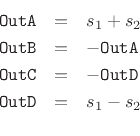![\includegraphics[width=\twidth]{eps/jcrevmus10}](img706.png) |
The subject of artificial reverberation was initiated in the early 1960s by Manfred Schroeder and Ben Logan [420,421,415]. Early Schroeder reverberators consisted of the following elements [415]:
![\includegraphics[width=\twidth]{eps/jcrevmus10}](img706.png) |
An example is shown in Fig.3.5, where, in that figure,
![$\displaystyle \eqsp \left[\begin{array}{rrrr}
1 & 1 & 1 & 1 \\ [2pt]
-1 & -1 & -1 & -1 \\ [2pt]
-1 & 1 & -1 & 1 \\ [2pt]
1 & -1 & 1 & -1
\end{array}\right]
$](img709.png)
which can be efficiently implemented using four adders and two negations:

|

|
As discussed above in §3.4.2, the allpass filters provide ``colorless'' high-density echoes in the late impulse response of the reverberator [420,421]. These allpass filters may also be referred to as diffusers. While allpass filters are ``colorless'' in theory, perceptually, their impulse responses are only colorless when they are extremely short (less than 10 ms or so). Longer allpass impulse responses sound similar to feedback comb-filters. For steady-state tones, however, such as sinusoids, the allpass property gives the same gain at every frequency, unlike comb filters.
Schroeder [415, p. 221] suggests a progression of allpass delay-line lengths close to

and chosen to be mutually prime (no common factors). The
The parallel comb-filter bank is intended to give a psychoacoustically appropriate fluctuation in the reverberator frequency response. As discussed in Chapter 2 (§2.6.2), a feedback comb filter can simulate a pair of parallel walls, so one could choose the delay-line length in each comb filter to be the number of samples it takes for a plane wave to propagate from one wall to the opposite wall and back. However, in his original paper [415], Schroeder describes a more psychoacoustically motivated approach:
``There are about 15 large response peaks in every 100 cps [Hz] interval for a room with 1 sec reverberation time. Thus, one might hope that if an artificial reverberator has a comparable number of response peaks it might sound just as good as a real room. We have been able to confirm this expectation by subjective evaluations of the responses of reverberators consisting of several comb filters ... connected in parallel. For a delay of 0.04 sec, the number of response peaks per 100 cps [Hz] is 4. Thus, between 3 and 4 comb filters in parallel ... with incommensurate delays, are required to approximate the number of peaks in the frequency reponse of a room having a reverberation time of T[60] = 1 sec. Also, the open loop gain of the comb filters should not exceed about 0.85 or -1.4 dB to keep the response fluctuations from being excessive.''Thus, one may choose the comb-filter delay-line lengths more or less arbitrarily, and then use enough of them in parallel (with mutually prime delay-line lengths) to achieve a perceptually adequate fluctuation density in the frequency-response magnitude. In [415], four such delays are chosen between 30 and 45 ms, and the corresponding feedback coefficients
The delay lengths shown in Fig.3.7 were optimized by ear by John
Chowning (and perhaps others at CCRMA) for an audio sampling rate of
![]() kHz.
kHz.
Finally, for multichannel listening, Schroeder suggested [415] a mixing matrix at the reverberator output. The goal of the mixing matrix is to bring out any number of uncorrelated audio channels of reverberation (for any number of output speakers) [154, p. 111-112].